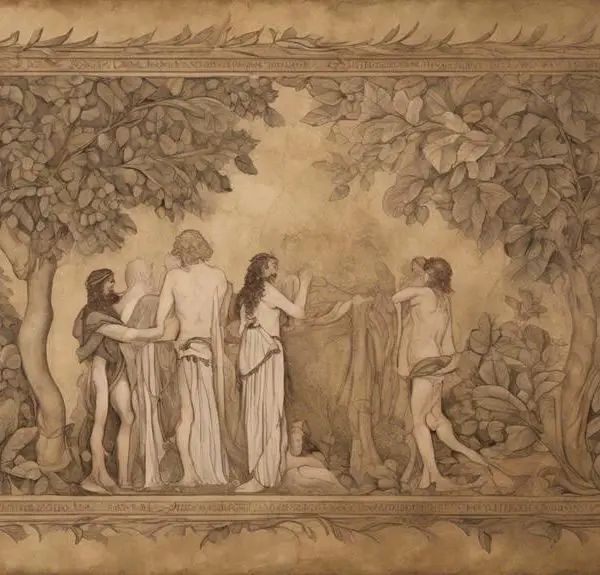Navigate the spiritual significance of white in the Bible, uncovering layers of purity, divine presence, and redemption that transcend mere color.

What Does White Mean in the Bible
As you peel back the layers of the biblical text, you'll find that white isn't just a color; it's a tapestry woven with threads of purity, righteousness, divine presence, and more.
This hue stands as a symbol for garments of righteousness, enveloping figures in an aura of sanctity, and it heralds divine presence and glory with unmatched clarity. From prophecies to promises of redemption, white carries a weight beyond its simple appearance.
As we explore these dimensions, you'll discover how white transcends mere color to embody profound spiritual truths, inviting you to look beyond the surface to the deeper meanings that lie beneath.
Key Takeaways
- White symbolizes purity and spiritual cleanliness, reflecting moral integrity in biblical contexts.
- It represents righteousness and believers' transformation towards holiness through faith.
- White signifies the divine presence and glory, embodying God's perfection and celestial light.
- It heralds the promise of redemption, symbolizing spiritual renewal and salvation.
Symbolism of Purity

In the biblical context, white often symbolizes purity, representing an unblemished state that reflects moral and spiritual cleanliness. This association isn't merely aesthetic; it's deeply woven into the fabric of scriptural narratives and laws concerning ritual cleanliness. You'll find that white transcends mere color, morphing into a symbol of divinity and righteousness that separates the sacred from the profane.
This symbolism is particularly evident in descriptions of celestial beings. Angels, for instance, are frequently depicted in white garments, embodying purity, holiness, and their unstained nature by virtue of their proximity to the Divine. Their appearance serves as a visual testament to their role as messengers and servants of God, untainted by the moral complexities and corruptions of the earthly realm.
Moreover, the emphasis on ritual cleanliness in the Bible further underscores the significance of white. Rituals involving the use of water, the donning of white garments, and even the selection of animals without blemish for sacrifices, all point to an intricate system where purity—both physical and spiritual—is paramount. These practices aren't just about adherence to divine commandments; they're also about the community's collective striving towards a state of holiness, facilitated by the symbolic power of white.
Garments of Righteousness
White garments in the Bible often serve as metaphors for righteousness, symbolizing the transformation and purification of believers through their faith and actions. This imagery isn't merely poetic but steeped in the ceremonial practices and cultural interpretation of ancient times. You'll find that these garments don't just represent an external purity but a profound internal change.
The wearing of white in biblical contexts often aligns with significant spiritual milestones or rituals, emphasizing a departure from sin towards a life marked by holiness and devotion. This transition isn't just personal but communal, reflecting a collective pursuit of purity and moral integrity within the faith community.
Analyzing these instances, it becomes clear that the symbolism transcends simple color interpretation. The white garments embody a tangible expression of an individual's commitment to righteousness, shaped by divine standards rather than human ones. This distinction is crucial, as it underlines the transformative power of divine intervention in a believer's life.
In essence, the biblical narrative utilizes the imagery of white garments to weave a complex tapestry of redemption, sanctification, and ultimately, divine approval. This isn't merely about adhering to ceremonial practices but about embodying the very essence of righteousness, as defined within a cultural and spiritual framework.
Divine Presence and Glory

Reflecting divine presence and glory, white in the Bible often symbolizes the tangible manifestation of God's proximity to His people. This color's association with divine presence is not arbitrary but deeply rooted in the narratives where heavenly light and angelic appearances are pivotal. White, in these contexts, acts as a bridge between the divine and the earthly, offering believers a glimpse into the celestial.
Aspect |
Significance |
|---|---|
Heavenly Light |
Represents purity, holiness, and God's perfection. |
Angelic Appearances |
Signify divine intervention and messages from God. |
When analyzing biblical texts, it's evident that white's usage is multifaceted but consistently points towards an otherworldly purity and glory. Angelic beings are often described as clothed in white, underscoring their divine origin and the purity of the messages they bear. Similarly, heavenly light, frequently depicted as white or blindingly bright, underscores the overwhelming and unapproachable holiness of God. This portrayal helps believers understand the immense gap between human and divine nature, yet it also emphasizes God's willingness to bridge this gap and commune with His creation. Through these manifestations, white conveys both the awe-inspiring majesty of God and His intimate presence among His people.
Prophecy and Revelation
Throughout biblical scripture, white frequently emerges as a symbol of prophecy and revelation, offering insights into divine will and end-time events. This color's presence in apocalyptic visions serves as a beacon, guiding believers to comprehend the profundity of divine messages. It's essential to dissect this symbolism to grasp its implications fully:
- Purity of Revelation: White, in the context of prophecy, underscores the unadulterated truth communicated by divine entities. Its purity symbolizes the clarity and honesty of the revelations bestowed upon prophets and seers.
- Harbingers of End Times: Apocalyptic literature, especially in the Book of Revelation, depicts white as the color of horses, robes, and clouds associated with significant end-time occurrences. These instances highlight white's role in signifying critical junctures in eschatological narratives.
- Transcendence of Divine Will: The use of white in prophetic discourse elevates the understanding of divine will above worldly concerns. It signifies a transcendental perspective, emphasizing that the ultimate unfolding of events aligns with a divine, rather than human, timeline.
The Promise of Redemption

In biblical narratives, the color white often heralds the promise of redemption, symbolizing a path to spiritual renewal and salvation for believers. This association isn't coincidental but deeply ingrained in the scripture's portrayal of cleansing rituals and new beginnings. As you delve deeper, you'll find that white isn't just a color but a profound symbol of purity and divine grace.
Cleansing rituals, pivotal in the biblical context, frequently employ the imagery of white to signify the washing away of sin and impurity. These rituals aren't mere physical acts but metaphors for spiritual purification, preparing individuals for a closer relationship with the divine. The use of white in these contexts isn't just about the absence of color; it's about the presence of all that's good, pure, and holy.
Furthermore, the promise of redemption through white underscores the hope of new beginnings. This isn't about erasing the past but transforming it, where past misdeeds and mistakes are washed clean, offering a blank slate. This aspect of white invites believers to embrace a journey of redemption, where each step forward is a step toward divine purity and salvation.
Frequently Asked Questions
How Has the Interpretation of White as a Symbol in the Bible Evolved From Ancient Times to Modern Christianity?
You're exploring how interpretations of white as a symbol have transformed from ancient beliefs to contemporary Christianity.
Initially, historical symbolism linked white to purity and divinity, deeply rooted in biblical narratives.
Over time, modern reinterpretations have broadened its meanings, reflecting societal changes and evolving theological understandings.
This shift illustrates the dynamic nature of religious symbolism, where white now encompasses a wider array of values and interpretations within the Christian faith.
In What Way Does the Cultural Context of the Bible's Original Audience Affect Our Understanding of the Color White's Significance?
Imagine stepping into a world where colors whisper secrets of the past.
In understanding cultural symbolism and the historical context of an audience, you delve deeper into the layers of meaning.
The significance of any color, including white, isn't universal but deeply embedded in cultural narratives.
Analyzing these aspects reveals how interpretations vary and why your appreciation of these nuances enriches your comprehension beyond a surface-level understanding.
Are There Any Instances Where the Color White in the Bible Has Been Interpreted Differently Across Various Christian Denominations?
Yes, the interpretation of the color white varies among Christian denominations due to differences in color symbolism and denominational practices.
For example, some see it as purity and holiness, integral to baptism and clergy attire, while others might emphasize its connection to resurrection and divine revelation more.
These interpretations reflect broader theological perspectives and traditions, showing how color symbolism can diverge significantly across denominational lines.
How Do Non-Christian Religions and Beliefs Interpret the Symbolism of the Color White, and Are There Parallels to Its Biblical Significance?
In exploring the symbolism of white beyond Christianity, you'll find its significance isn't confined to one interpretation.
In Islam, white embodies purity, often seen in attire for religious rituals, reflecting a clean heart.
Similarly, in Hinduism, white symbolizes peace, marking a serene approach to life and spirituality.
These parallels suggest a universal reverence for white across beliefs, highlighting its broader spiritual significance beyond its biblical context.
It's a testament to white's transcendent purity and peace.
What Are Some of the Critiques or Controversies Surrounding the Exclusive Association of the Color White With Positive Attributes in Religious Texts?
You're delving into how color psychology and modern fashion trends critique the exclusive positive portrayal of white in religious texts. Analyzing this, you'll find that white's symbolism isn't universally accepted as purely positive.
Critics argue this exclusivity overlooks cultural diversity and the multifaceted meanings of colors. This analytical approach highlights the need for a broader interpretation that acknowledges white's complexity and its varied significance across different contexts and beliefs.
Conclusion
In your exploration of white symbolism within the Bible, you've journeyed through its multifaceted representations—from purity and righteousness to divine presence and prophecy.
Interestingly, over 100 verses explicitly utilize white to convey these spiritual complexities, underscoring its profound significance. This statistic not only highlights white's pervasive symbolism but also invites you to ponder its deeper implications within a biblical context.
As you reflect, consider how white's purity and promise of redemption resonate within your own spiritual journey, enriching your understanding of biblical narratives.



Sign up